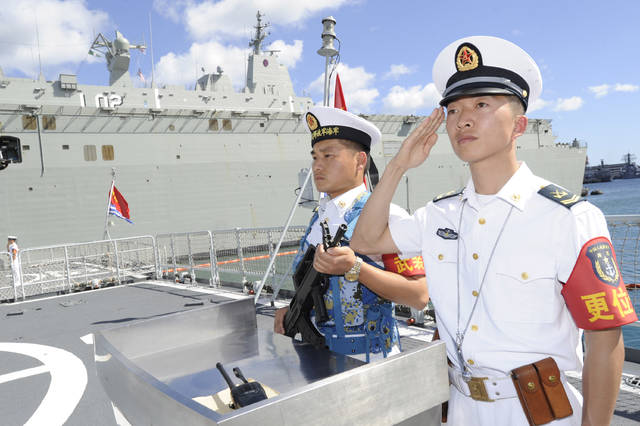China says it will participate in RIMPAC

BRUCE ASATO / 2016
Security personnel greet people boarding the CNS Xi’an while docked at Pearl Harbor.
Amid ongoing spats between China and the United States in the South China Sea, Beijing confirmed today it will participate in this summer’s big Rim of the Pacific exercise off Hawaii June 27 to Aug. 2.
“The Chinese side has received the invitation from the U.S. side,” Senior Col. Wu Qian, a spokesman for China’s Ministry of National Defense, said at a press conference. “Lately we sent representatives to participate in the (mid-planning conference) of the RIMPAC and discussed details with the U.S. side for the arrangement of China’s participation.”
It was not clear what forces China will send.
RIMPAC is held every other year. In 2016, China sent the missile destroyer Xi’an, missile frigate Hengshui, supply ship Gaoyouhu, submarine rescue vessel Changdao and hospital ship Peace Ark and participated in at-sea drills including gunfire, damage control and rescue, anti-piracy, search and rescue and diving and submarine rescue.
The last RIMPAC saw participation by 26 nations, 25,000 personnel, 45 ships, five submarines and more than 200 aircraft. The interoperability drills were held mostly in and around the Hawaiian Islands but also off Southern California.
The U.S. Navy’s Third Fleet in San Diego, which plans RIMPAC, said the initial planning conference was held in San Diego June 6-9. The mid-planning conference was held at Pearl Harbor Dec. 5-8. The final planning conference is scheduled for the first week of April, the Navy said.
Don't miss out on what's happening!
Stay in touch with breaking news, as it happens, conveniently in your email inbox. It's FREE!
All 26 nations that participated in 2016 were re-invited in April, according to the Navy.
China typically sends a delegation of between five and eight representatives to each planning session, which is similar to the number sent by Canada or Australia, said Third Fleet spokeswoman Lt. Cmdr. Julie Holland.
Holland said Third Fleet won’t know the full participation make-up until after April.
“Nothing’s been finalized until the final planning conference,” she said. “So yes, we have been in discussions with the (People’s Liberation Army Navy) about their participation in RIMPAC, just as we have with Australia, (Canada), New Zealand,” Holland said.
Wu, China’s Ministry of National Defense spokesman, responded to a question at the same press conference about a comment made by Adm. Harry Harris, who heads U.S. Pacific Command on Oahu, at a security conference in India earlier this month.
News agency Reuters reported that Harris said, “I believe the reality is that China is a disruptive transitional force in the Indo-Pacific.”
Harris is known to be a hardliner against China’s expansionism in the South China Sea, which the United States worries will up-end a free flow of commerce and limit the U.S. military’s dominant role in the region since the end of World War II.
“The American admiral described China as disruptive,” Wu said. “But if there is anything China wants to disrupt, it is nothing but the hegemonic thinking and the cold war mentality that some people cling to so dearly.”
China recently complained that the Pearl Harbor destroyer USS Hopper sailed on Jan. 17 near Scarborough Shoal in the South China Sea — territory claimed by China, the Philippines and Taiwan — in what the United States calls a freedom of navigation operation.
The shoal, which China calls Huangyan Dao, is about 120 miles west of Luzon in the Philippines.
China Foreign Ministry spokesman Lu Kang said Hopper sailed within 12 nautical miles of Scarborough Shoal “without gaining permission from the Chinese government.”
China state news agency Xinhua reported that the defense ministry told the United States not to “cause trouble out of nothing,” and to respect the sovereignty of China.
After Hopper entered waters around Scarborough Shoal, the Chinese missile destroyer Huangshan “immediately conducted an identification and warning process to drive it away,” Xinhua said.
The U.S. Navy periodically conducts freedom of navigation operations near disputed islands in the South China Sea.
China claims much of the region as its territory and has created manmade islands fortified with missile defenses.
Despite past South China Sea provocations — with some lawmakers calling for China’s RIMPAC invitation to be rescinded — the U.S. military two years ago said it saw the exercise as a way to interact positively with China, even if it disagreed with its actions elsewhere.
Adm. Scott Swift, head of U.S. Pacific Fleet, said at an opening event for the last RIMPAC that “inclusivity” was a tenet of the prestigious exercise.
Before the exercise kicked off, Chief of Naval Operations Adm. John Richardson said China was welcome to attend.
“These (exercises) are the sorts of things that bring us all together in sort of positive, constructive ways,” Richardson said.


 Shine from the Inside! A Women's Empowerment Workshop
Shine from the Inside! A Women's Empowerment Workshop 

